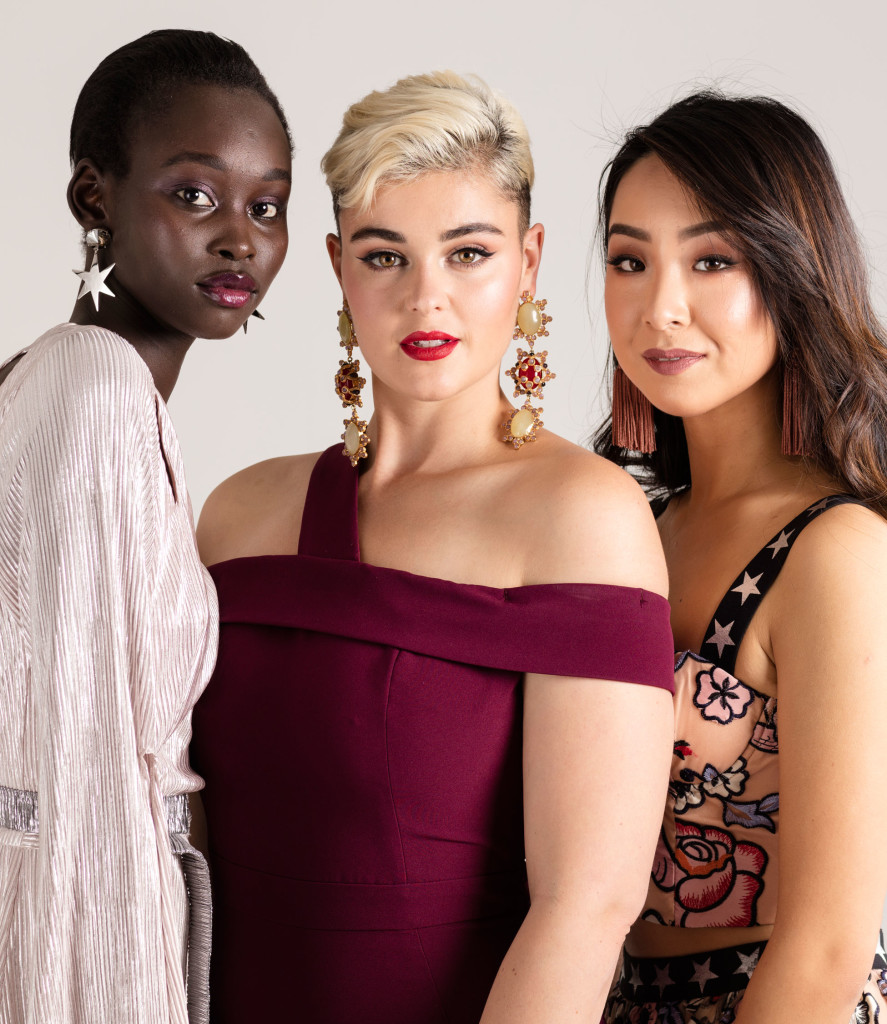With one word and three beautiful faces, Melbourne Fashion Week has plugged into one of the most significant cultural quakes this century – diversity. By Janice Breen Burns.
This cover story first appeared in The Weekly Review
It’s a revolution for inclusion and many fashion insiders in multicultural Melbourne regard it as logical and long overdue. Fashion week’s three female ambassadors this year are on the revolution’s front line. For many young women of non-model proportions and diverse heritage, they’re also a thrilling revelation after the decades of stereotypically pretty, whippet-slim Caucasians assigned the ambassador role. This year it was split, with South Sudan-born supermodel, Ajak Deng, Chinese-Australian, Kristy Wu and Stefania Ferrario, a regular size 12, sharing the limelight.

(L-R) Subah Koj, Kristy Wu & Stefania Ferrario. Photo: Michael Rayner. Styling: Lana Wilkinson. Makeup: Mecca
African-Australian Subah Koj, pictured here with Kristy and Stefania, is also among the many talented models cast for MFW’s 20 key runway shows. “Diversity has created a big, overall shift in fashion here and overseas,” says MFW head stylist Kate Gaskin. “We’re moving away from the same, stereotypical girls to more individuality, more personality.” She says casting is more about merit, ability and quirky aesthetics now. “Ethnicity, sexuality, even height aren’t relevant, as long as a girl fits the concept of a show and is a strong walker.”
Beyond MFW, the diversity revolution is global and growing. Almost 30 per cent of models who walked in the Paris, New York, London and Milan shows this year were people of colour, according to industry bible Business of Fashion. And a new generation of casting agents is skirting the problem of Caucasian-dominated model agencies by hiring “nodels” with the right look from the street. “Anyone can be the most beautiful girl in the world,” Kate says.
Meet Melbourne Fashion Week’s ambassadors…..
Subah Koj

SUBAH WEARS Asilio dress, Windsor Smith shoes, Alicia Dash jewellery. Thanks to Vivien’s Models
(L-R) Subah Koj, Kristy Wu & Stefania Ferrario. Photo: Michael Rayner. Styling: Lana Wilkinson. Makeup: Mecca
A beauty born at precisely the right moment in history; Subah Koj, 19, is keenly aware of her role in Australian fashion’s awakening. “I feel very proud to have been a part of the shift towards diversity,” she says. “Now I have a lot of younger cousins who want to pursue modelling because they feel more confident and comfortable.”
Subah was tiny when her family fled civil war in Sudan. They lived for several years in Egypt before arriving in Melbourne in 2005. She remembers her parents working punishing hours. “They said it’s an honour to be here,” she says. “To be able to own a house and cars.” She followed suit, packing her days with sports, study and part-time jobs. “I have the motivation to do better for myself and maybe go back [to Sudan] some day and help.” At 15, she also managed to squeeze a modelling course into her frenetic schedule; “to learn pose and posture and poise”. Subah was “discovered” at age 16 by Melbourne model agent and diversity advocate Stephen Bucknall of FRM at a Miss South Sudan beauty quest (she came third). Since then she has modelled for Vogue, Marie Claire, David Jones, Melbourne Spring Fashion weeks and festivals, and Australian Fashion Week. And she has no thoughts of slowing, as she juggles modelling with sports and an RMIT business course. “I just love it,” she says.
Kristy Wu

KRISTY WU WEARS \ Asilio dress, Tony Bianco shoes, Vintage jewellery. Thanks to Day Management
At 17, when followers of her first blog and Instagram accounts were rocketing, influencer Kristy Wu had a marvellous observation about social media. “Diversity’s already there,” she says. “Social media has significantly broken down barriers that would’ve been an issue decades ago.” There might not have been many models of Asian heritage on Australian runways until recently, but there was always inspiration for the young Kristy, now 21, in the digital realm. “I followed people like Margaret Zhang and the Gary Pepper blog [founded by Nicole Warne], Aimee Song,” she says. “They’re such amazing, strong-minded women.” There are now many prominent Asian-Australian voices on social media, and Kristy stands out, an inspiration in her own right. Daily posts of her chic, mostly monochromatic, wardrobe have evolved into a small digital business she hopes to one day combine with her marketing degree (she has one semester to go at Monash). In the meantime, she’s happy to be at the front lines wherever barriers are being breached. “It’s empowering, this direction the whole fashion industry is taking on diversity.”
Stefania Ferrario

STEFANIA WEARS \ Mossman dress, YSL shoes, Christie Nicolaides jewellery. Thanks to Bella Management
Irony is a way of life for size-12 model Stefania Ferrario. Despite being slimmer than the estimated 50 per cent of Australian women who are size 14 and above, the 24-year-old is often labelled a “plus-size” model, as if her trim little figure were somehow abnormal. “We’ve had this unfortunate label whacked on us,” Stefania says, “but we’re actually in a healthy weight range.” She worries, especially, about young girls, who can become enmeshed in fashion’s “skinny model” message. “They see models their own size being labelled ‘plus-size’; how’s that make them feel?” She believes a simple switch to words like “curvy” might diffuse the stigma. Diversity across fashion campaigns and runways will also solve issues for a majority of women. “I’m for diversity,” she says. “I’m glad fashion is moving in that direction, reflecting the consumers who are actually spending money on clothing.” Stefania, who has modelled for Target and Myer’s Dita Von Teese range, attended a French secondary school in Canberra, speaks three languages and plans to return to study (probably languages) if her modelling career slows down. Right now though, it’s ticking along nicely: “I do love it, being in front of the camera.”


